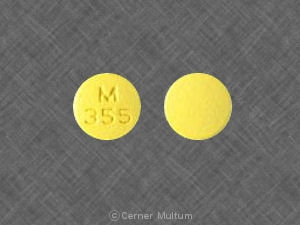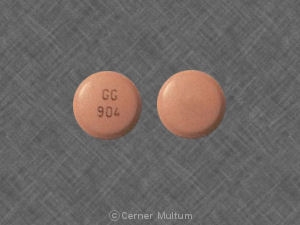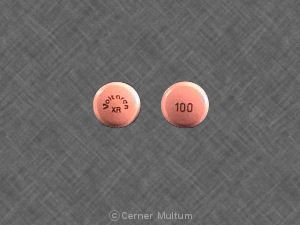



































































Components:
Treatment option:
Medically reviewed by Kovalenko Svetlana Olegovna, PharmD. Last updated on 26.06.2023

Attention! Information on this page is intended only for medical professionals! Information is collected in open sources and may contain significant errors! Be careful and double-check all the information on this page!
Dosage Forms And Strengths
CAMBIA is available in individual packets each designed to deliver a 50 mg dose when mixed in water.
Storage And Handling
CAMBIA (diclofenac potassium) 50 mg, is a white to off-white, buffered, flavored powder for oral solution, supplied as one or more sets of three perforated co-joined individual dose packets. Each individual packet is designed to deliver a dose of 50 mg diclofenac potassium when mixed in water.
NDC 13913-012-01 Individual
CAMBIA Packets
NDC 13913-012-03 Boxes of nine
(9) CAMBIA Packets
Storage
Store at 25°C (77°F). Excursions permitted from 15°C-30°C (59°F86°F).
Distributed by: Depomed, Inc. Newark, CA 94560 For more information, go to www. CambiaRx.com or call 1-866-458-6389. Revised: Mar 2017
- R52.1 – Chronic intractable pain
- R52.2 – Other chronic pain
- R52.9 – Unspecified pain
CAMBIA is indicated for the acute treatment of migraine attacks with or without aura in adults (18 years of age or older).
Limitations Of Use
- CAMBIA is not indicated for the prophylactic therapy of migraine.
- The safety and effectiveness of CAMBIA have not been established for cluster headache, which is present in an older, predominantly male population.
Acute Treatment Of Migraine
Administer one packet (50 mg) of CAMBIA for the acute treatment of migraine. Empty the contents of one packet into a cup containing 1 to 2 ounces or 2 to 4 tablespoons (30 to 60 mL) of water, mix well and drink immediately.
Do not use liquids other than water.
Taking CAMBIA with food may cause a reduction in effectiveness compared to taking CAMBIA on an empty stomach.
Use the lowest effective dose for the shortest duration consistent with individual patient treatment goals. The safety and effectiveness of a second dose have not been established.
Non-Interchangeability With Other Formulations Of Diclofenac
Different formulations of oral diclofenac (e.g., CAMBIA, diclofenac sodium enteric-coated tablets, diclofenac sodium extended-release tablets, or diclofenac potassium immediate-release tablets) may not be bioequivalent even if the milligram strength is the same. Therefore, it is not possible to convert dosing from any other formulation of diclofenac to CAMBIA.
CAMBIA is contraindicated in the following patients:
- Known hypersensitivity (e.g., anaphylactic reactions and serious skin reactions) to diclofenac or any components of the drug product
- History of asthma, urticaria, or other allergic-type reactions after taking aspirin or other NSAIDs. Severe, sometimes fatal, anaphylactic reactions to NSAIDs have been reported in such patients
- In the setting of coronary artery bypass graft (CABG) surgery
WARNINGS
Included as part of the PRECAUTIONS section.
PRECAUTIONS
Cardiovascular Thrombotic Events
Clinical trials of several COX-2 selective and nonselective NSAIDs of up to three years duration have shown an increased risk of serious cardiovascular (CV) thrombotic events, including myocardial infarction(MI) and stroke, which can be fatal. Based on available data, it is unclear that the risk for CV thrombotic events is similar for all NSAIDs. The relative increase in serious CV thrombotic events over baseline conferred by NSAID use appears to be similar in those with and without known CV disease or risk factors for CV disease. However, patients with known CV disease or risk factors had a higher absolute incidence of excess serious CV thrombotic events, due to their increased baseline rate. Some observational studies found that this increased risk of serious CV thrombotic events began as early as the first weeks of treatment. The increase in CV thrombotic risk has been observed most consistently at higher doses.
To minimize the potential risk for an adverse CV event in NSAID-treated patients, use the lowest effective dose for the shortest duration possible. Physicians and patients should remain alert for the development of such events, throughout the entire treatment course, even in the absence of previous CV symptoms. Patients should be informed about the symptoms of serious CV events and the steps to take if they occur.
There is no consistent evidence that concurrent use of aspirin mitigates the increased risk of serious CV thrombotic events associated with NSAID use. The concurrent use of aspirin and an NSAID, such as diclofenac, increases the risk of serious gastrointestinal (GI) events.
Status Post Coronary Artery Bypass Graft (CABG) Surgery
Two large, controlled clinical trials of a COX-2 selective NSAID for the treatment of pain in the first 10-14 days following CABG surgery found an increased incidence of myocardial infarction and stroke. NSAIDs are contraindicated in the setting of CABG.
Post-MI Patients
Observational studies conducted in the Danish National Registry have demonstrated that patients treated with NSAIDs in the post-MI period were at increased risk of reinfarction, CV-related death, and all-cause mortality beginning in the first week of treatment. In this same cohort, the incidence of death in the first year post-MI was 20 per 100 person years in NSAID-treated patients compared to 12 per 100 person years in non-NSAID exposed patients. Although the absolute rate of death declined somewhat after the first year post-MI, the increased relative risk of death in NSAID users persisted over at least the next four years of follow-up.
Avoid the use of CAMBIA in patients with a recent MI unless the benefits are expected to outweigh the risk of recurrent CV thrombotic events. If CAMBIA is used in patients with a recent MI, monitor patients for signs of cardiac ischemia.
Gastrointestinal Bleeding, Ulceration, And Perforation
NSAIDs, including diclofenac, cause serious gastrointestinal (GI) adverse events including inflammation, bleeding, ulceration, and perforation of the esophagus, stomach, small intestine, or large intestine, which can be fatal. These serious adverse events can occur at any time, with or without warning symptoms, in patients treated with NSAIDs. Only one in five patients who develop a serious upper GI adverse event on NSAID therapy is symptomatic. Upper GI ulcers, gross bleeding, or perforation caused by NSAIDs occurred in approximately 1% of patients treated for 3-6 months, and in about 2%-4% of patients treated for one year. However, even short-term NSAID therapy is not without risk.
Risk Factors For GI Bleeding, Ulceration, And Perforation
Patients with a prior history of peptic ulcer disease and/or GI bleeding who used NSAIDs had a greater than 10fold increased risk for developing a GI bleed compared to patients without these risk factors. Other factors that increase the risk for GI bleeding in patients treated with NSAIDs include longer duration of NSAID therapy; concomitant use of oral corticosteroids, aspirin, anticoagulants, or selective serotonin reuptake inhibitors (SSRI); smoking; use of alcohol; older age; and poor general health status. Most postmarketing reports of fatal GI events occurred in elderly or debilitated patients. Additionally, patients with advanced liver disease and/or coagulopathy are at increased risk for GI bleeding.
Strategies to Minimize the GI Risk in NSAID-treated Patients:
- Use the lowest effective dosage for the shortest possible duration.
- Avoid administration of more than one NSAID at a time.
- Avoid use in patients at higher risk unless benefits are expected to outweigh the increased risk of bleeding. For high risk patients, as well as those with active GI bleeding, consider alternate therapies other than NSAIDs.
- Remain alert for signs and symptoms of GI ulceration and bleeding during NSAID therapy.
- If a serious GI adverse event is suspected, promptly initiate evaluation and treatment, and discontinue CAMBIA until a serious GI adverse event is ruled out.
- In the setting of concomitant use of low-dose aspirin for cardiac prophylaxis, monitor patients more closely for evidence of GI bleeding .
Hepatotoxicity
Elevations of one or more liver tests may occur during therapy with CAMBIA. These laboratory abnormalities may progress, may persist, or may only be transient with continued therapy. Borderline elevations (less than 3 times the upper limit of the normal [ULN] range) or greater elevations of transaminases occurred in about 15% of diclofenac-treated patients. Of the markers of hepatic function, ALT (SGPT) is recommended for the monitoring of liver injury.
In clinical trials, meaningful elevations (i.e., more than 3 times the ULN) of AST (SGOT) occurred in about 2% of approximately 5,700 patients at some time during treatment (ALT was not measured in all studies). In an open-label, controlled trial of 3,700 patients treated for 2-6 months, patients were monitored at 8 weeks and 1,200 patients were monitored again at 24 weeks. Meaningful elevations of ALT and/or AST occurred in about 4% of the 3,700 patients and included marked elevations ( > 8 times the ULN) in about 1% of the 3,700 patients. In this open-label study, a higher incidence of borderline (less than 3 times the ULN), moderate (3-8 times the ULN), and marked ( > 8 times the ULN) elevations of ALT or AST was observed in patients receiving diclofenac when compared to other NSAIDs. Almost all meaningful elevations in transaminases were detected before patients became symptomatic.
Abnormal tests occurred during the first 2 months of therapy with diclofenac in 42 of the 51 patients in all trials who developed marked transaminase elevations. In postmarketing reports, cases of drug-induced hepatotoxicity have been reported in the first month, and in some cases, the first 2 months of NSAID therapy, but can occur at any time during treatment with diclofenac.
Postmarketing surveillance has reported cases of severe hepatic reactions, including liver necrosis, jaundice, fulminant hepatitis with and without jaundice, and liver failure. Some of these reported cases resulted in fatalities or liver transplantation.
Inform patients of the warning signs and symptoms of hepatotoxicity (e.g., nausea, fatigue, lethargy, diarrhea, pruritus, jaundice, right upper quadrant tenderness, and “flu-like” symptoms). If clinical signs and symptoms consistent with liver disease develop, or if systemic manifestations occur (e.g., eosinophilia, rash, etc.), discontinue CAMBIA immediately, and perform a clinical evaluation of the patient.
To minimize the potential risk for an adverse liver-related event in patients treated with CAMBIA, use the lowest effective dose for the shortest duration possible. Exercise caution when prescribing CAMBIA with concomitant drugs that are known to be potentially hepatotoxic (e.g., acetaminophen, certain antibiotics, antiepileptics). Caution patients to avoid taking nonprescription acetaminophen-containing products while using CAMBIA.
Hypertension
NSAIDs, including CAMBIA, can lead to new onset of hypertension or worsening of pre-existing hypertension, either of which may contribute to the increased incidence of CV events. Use NSAIDs, including CAMBIA, with caution in patients with hypertension. Monitor blood pressure closely during the initiation of NSAID treatment and throughout the course of therapy.
Patients taking angiotensin converting enzyme (ACE) inhibitors, thiazides, or loop diuretics may have impaired response to these therapies when taking NSAIDs.
Heart Failure And Edema
The Coxib and traditional NSAID Trialists' Collaboration meta-analysis of randomized controlled trials demonstrated an approximately two-fold increase in hospitalizations for heart failure in COX-2 selective-treated patients and nonselective NSAID-treated patients compared to placebo-treated patients. In a Danish National Registry study of patients with heart failure, NSAID use increased the risk of MI, hospitalization for heart failure, and death.
Additionally, fluid retention and edema have been observed in some patients treated with NSAIDs. Use of diclofenac may blunt the CV effects of several therapeutic agents used to treat these medical conditions (e.g., diuretics, ACE inhibitors, or angiotensin receptor blockers [ARBs]).
Avoid the use of CAMBIA in patients with severe heart failure unless the benefits are expected to outweigh the risk of worsening heart failure. If CAMBIA is used in patients with severe heart failure, monitor patients for signs of worsening heart failure.
Renal Toxicity And Hyperkalemia
Renal Toxicity
Long-term administration of NSAIDs has resulted in renal papillary necrosis and other renal injury. Renal toxicity has also been seen in patients in whom renal prostaglandins have a compensatory role in the maintenance of renal perfusion. In these patients, administration of an NSAID may cause a dose-dependent reduction in prostaglandin formation and, secondarily, in renal blood flow, which may precipitate overt renal decompensation. Patients at greatest risk of this reaction are those with impaired renal function, dehydration, hypovolemia, heart failure, liver dysfunction, those taking diuretics and ACE inhibitors or ARBs, and the elderly. Discontinuation of NSAID therapy is usually followed by recovery to the pretreatment state.
No information is available from controlled clinical studies regarding the use of CAMBIA in patients with advanced renal disease. The renal effects of CAMBIA may hasten the progression of renal dysfunction in patients with pre-existing renal disease.
Correct volume status in dehydrated or hypovolemic patients prior to initiating CAMBIA. Monitor renal function in patients with renal or hepatic impairment, heart failure, dehydration, or hypovolemia during use of CAMBIA. Avoid the use of CAMBIA in patients with advanced renal disease unless the benefits are expected to outweigh the risk of worsening renal function. If CAMBIA is used in patients with advanced renal disease, monitor patients for signs of worsening renal function.
Hyperkalemia
Increases in serum potassium concentration, including hyperkalemia, have been reported with use of NSAIDs, even in some patients without renal impairment. In patients with normal renal function, these effects have been attributed to a hyporeninemic-hypoaldosteronism state.
Anaphylactic Reactions
Diclofenac has been associated with anaphylactic reactions in patients with and without known hypersensitivity to diclofenac and in patients with aspirin-sensitive asthma.
Seek emergency help if an anaphylactic reaction occurs.
Exacerbation Of Asthma Related To Aspirin Sensitivity
A subpopulation of patients with asthma may have aspirin-sensitive asthma which may include chronic rhinosinusitis complicated by nasal polyps; severe, potentially fatal bronchospasm; and/or intolerance to aspirin and other NSAIDs. Because cross-reactivity between aspirin and other NSAIDs has been reported in such aspirin-sensitive patients, CAMBIA is contraindicated in patients with this form of aspirin sensitivity. When CAMBIA is used in patients with preexisting asthma (without known aspirin sensitivity), monitor patients for changes in the signs and symptoms of asthma.
Serious Skin Reactions
NSAIDs, including diclofenac, can cause serious skin adverse reactions such as exfoliative dermatitis, Stevens-Johnson Syndrome (SJS), and toxic epidermal necrolysis (TEN), which can be fatal. These serious events may occur without warning. Inform patients about the signs and symptoms of serious skin reactions, and to discontinue the use of CAMBIA at the first appearance of skin rash or any other sign of hypersensitivity. CAMBIA is contraindicated in patients with previous serious skin reactions to NSAIDs.
Medication Overuse Headache
Overuse of acute migraine drugs (e.g., ergotamine, triptans, opioids, nonsteroidal anti-inflammatory drugs or combination of these drugs for 10 or more days per month) may lead to exacerbation of headache (medication overuse headache). Medication overuse headache may present as migraine-like daily headaches or as a marked increase in frequency of migraine attacks. Detoxification of patients, including withdrawal of the overused drugs and treatment of withdrawal symptoms (which often includes a transient worsening of headache) may be necessary.
Premature Closure Of Fetal Ductus Arteriosus
CAMBIA can cause fetal harm when administered to a pregnant woman. Starting at 30 weeks gestation, CAMBIA and other NSAIDs should be avoided by pregnant women as premature closure of the ductus arteriosus in the fetus may occur. If this drug is used during this time period in pregnancy, the patient should be apprised of the potential hazard to a fetus.
Hematologic Toxicity
Anemia has occurred in NSAID-treated patients. This may be due to occult or gross blood loss, fluid retention, or an incompletely described effect upon erythropoiesis. If a patient treated with CAMBIA has any signs or symptoms of anemia, monitor hemoglobin or hematocrit.
NSAIDs, including CAMBIA, may increase the risk of bleeding events. Concomitant use of warfarin and other anticoagulants, antiplatelet agents (e.g., aspirin), and serotonin reuptake inhibitors (SSRIs) and serotonin norepinephrine reuptake inhibitors (SNRIs) may increase this risk. Monitor these patients and any patient who may be adversely affected by alterations in platelet function for signs of bleeding.
Masking Of Inflammation And Fever
The pharmacological activity of CAMBIA in reducing inflammation, and possibly fever, may diminish the utility of diagnostic signs in detecting infections.
Laboratory Monitoring
Because serious GI bleeding, hepatotoxicity, and renal injury can occur without warning symptoms or signs, consider monitoring patients on long-term NSAID treatment with a CBC and a chemistry profile periodically.
Discontinue CAMBIA if abnormal liver tests or renal tests persist or worsen.
Patient Counseling Information
Advise the patient to read the FDA-approved patient labeling (Medication Guide) that accompanies each prescription dispensed. Inform patients, families, or their caregivers of the following information before initiating therapy with CAMBIA and periodically during the course of ongoing therapy.
Cardiovascular Thrombotic Events
Advise patients to be alert for the symptoms of cardiovascular thrombotic events, including chest pain, shortness of breath, weakness, or slurring of speech, and to report any of these symptoms to their health care provider immediately.
Gastrointestinal Bleeding, Ulceration, And Perforation
ICAMBIA, like other NSAIDS, can cause GI discomfort and more serious GI adverse events such as ulcers and bleeding, which may result in hospitalization and even death. Inform patients of the increased risk, and advise patients to report symptoms of ulcerations and bleeding, including epigastric pain, dyspepsia, melena, and hematemesis to their health care provider. Inform patients of the importance of follow-up in the setting of concomitant use of low-dose aspirin for cardiac prophylaxis.
Medication Overuse Headache
Inform patients that use of acute migraine drugs for 10 or more days per month may lead to an exacerbation of headache and encourage patients to record headache frequency and drug use (e.g., by keeping a headache diary).
Hepatotoxicity
Inform patients of the warning signs and symptoms of hepatotoxicity (e.g., nausea, fatigue, lethargy, pruritus, diarrhea, jaundice, right upper quadrant tenderness, and “flu-like” symptoms). If these occur, instruct patients to stop CAMBIA and seek immediate medical therapy.
Heart Failure And Edema
Advise patients to be alert for the symptoms of congestive heart failure including shortness of breath, unexplained weight gain, or edema and to contact their healthcare provider if such symptoms occur.
Anaphylactic Reactions
Inform patients of the signs of an anaphylactic reaction (e.g., difficulty breathing, swelling of the face or throat). Instruct patients to seek immediate emergency help if these occur.
Serious Skin Reactions
Advise patients to stop CAMBIA immediately if they develop any type of rash, blisters, fever or other signs of hypersensitivity such as itching and to contact their healthcare provider as soon as possible. CAMBIA, like other NSAIDS, can cause serious skin reactions such as exfoliative dermatitis, Stevens-Johnson syndrome (SJS), and toxic epidermal necrosis (TEN), which may result in hospitalizations and even death.
Effects During Pregnancy
Inform patients that starting at 30 weeks gestation, CAMBIA and other NSAIDs should be avoided by pregnant women as premature closure of the ductus arteriosus in the fetus may occur.
Avoid Concomitant Use Of NSAIDs
Inform patients that the concomitant use of CAMBIA with other NSAIDs or salicylates (e.g., diflunisal, salsalate) is not recommended due to the increased risk of gastrointestinal toxicity, and little or no increase in efficacy. Alert patients that NSAIDs may be present in “over the counter” medications for treatment of colds, fever, or insomnia.
Use Of NSAIDS And Low-Dose Aspirin
Inform patients not to use low-dose aspirin concomitantly with CAMBIA until they talk to their healthcare provider.
Nonclinical Toxicology
Carcinogenesis, Mutagenesis, And Impairment Of Fertility
Carcinogenesis
Long term carcinogenicity studies in rats given
Use In Specific Populations
Pregnancy
Pregnancy Category C prior to 30 weeks gestation; Category D starting at 30 weeks gestation.
Starting at 30 weeks gestation, CAMBIA, and other NSAIDS, should be avoided by pregnant women as premature closure of the ductus arteriosus in the fetus may occur. There are no adequate and well controlled studies in pregnant women.
Prior to 30 weeks gestation, CAMBIA should be used during pregnancy only if the potential benefit justifies the potential risk to the fetus.
Reproductive studies have been performed in mice given diclofenac sodium (up to 20 mg/kg/day, 2 times the recommended human dose [RHD] of 50 mg/day on a body surface area [mg/m² basis), and in rats and rabbits given diclofenac sodium (up to 10 mg/kg/day; 2 [rats] and 4 [rabbits] times the RHD on a mg/m² basis) and have revealed no evidence of teratogenicity despite the induction of maternal toxicity and fetal toxicity. In rats, maternally toxic doses were associated with dystocia, prolonged gestation, reduced fetal weights and growth, and reduced fetal survival.
Labor And Delivery
The effects of CAMBIA on labor and delivery in pregnant women are unknown. In rat studies, maternal exposure to NSAIDs, as with other drugs known to inhibit prostaglandin synthesis, increased the incidence of dystocia, delayed parturition, and decreased pup survival.
Nursing Mothers
It is not known whether this drug is excreted in human milk. Because many drugs are excreted in human milk and because of the potential for serious adverse reactions in nursing infants from CAMBIA, a decision should be made whether to discontinue nursing or to discontinue the drug, taking into account the importance of the drug to the mother.
Pediatric Use
Safety and effectiveness in pediatric patients have not been established.
Geriatric Use
Elderly patients, compared to younger patients, are at greater risk for NSAID-associated serious cardiovascular, gastrointestinal, and/or renal adverse reactions. If the anticipated benefit for the elderly patient outweighs these potential risks, monitor patients for adverse effects.
Clinical studies of CAMBIA did not include sufficient numbers of subjects aged 65 and over to determine whether they respond differently from younger subjects.
Hepatic Impairment
Because hepatic metabolism accounts for almost 100% of diclofenac elimination, patients with hepatic impairment should be considered for treatment with CAMBIA only if the benefits outweigh the risks. There is insufficient information available to support dosing recommendations for CAMBIA in patients with hepatic insufficiency.
Renal Impairment
No information is available from controlled clinical studies regarding the use of CAMBIA in patients with advanced renal disease. Therefore, treatment with CAMBIA is not recommended in patients with advanced renal disease. If CAMBIA therapy must be initiated, close monitoring of the patient's renal function is advisable.
diclofenac sodium up to 2 mg/kg/day (less than the recommended human dose [RHD] of 50 mg/day on a body surface area [mg/m²] basis) have revealed no significant increases in tumor incidence. There was a slight increase in benign mammary fibroadenomas in mid-dose treated (0.5 mg/kg/day or 3 mg/m²/day) female rats (high-dose females had excessive mortality), but the increase was not significant for this common rat tumor. A 2-year carcinogenicity study conducted in mice employing diclofenac sodium at doses up to 0.3 mg/kg/day (less than the RHD on a mg/m² basis) in males and 1 m/kg/day (less than the RHD on a mg/m² basis) in females did not reveal any oncogenic potential.Mutagenesis
Diclofenac sodium was not genotoxic in in vitro (reverse mutation in bacteria [Ames], mouse lymphoma tk) or in in vivo (including dominant lethal and male germinal epithelial chromosomal aberration in Chinese hamster) assays.
Impairment Of Fertility
Diclofenac sodium administered to male and female rats at 4 mg/kg/day (less than the RHD on a mg/m² basis) did not affect fertility.
SIDE EFFECTS
The following serious adverse reactions are discussed in greater detail in other sections of the labeling:
- Cardiovascular Thrombotic Events
- GI Bleeding, Ulceration and Perforation
- Hepatotoxicity
- Hypertension
- Heart Failure and Edema
- Renal Toxicity and Hyperkalemia
- Anaphylactic Reactions
- Serious Skin Reactions
- Hematologic Toxicity
Clinical Trials Experience
Because clinical trials are conducted under widely varying conditions, adverse reaction rates observed in the clinical trials of a drug cannot be directly compared with rates in the clinical trials of another drug and may not reflect the rates observed in practice.
The safety of a single dose of CAMBIA was evaluated in 2 placebo-controlled trials with a total of 634 migraine patients treated with CAMBIA for a single migraine headache. Following treatment with diclofenac potassium (either CAMBIA or diclofenac potassium immediate-release tablets [as a control]), 5 subjects (0.8%) withdrew from the studies; following placebo exposure, 1 subject (0.2%) withdrew. The most common adverse reactions (i.e., that occurred in 1% or more of CAMBIA-treated patients) and more frequent with CAMBIA than with placebo were nausea and dizziness (see Table 1).
Table 1: Adverse Reactions With Incidence > 1% and
Greater Than Placebo in Studies 1 and 2 Combined
| Adverse Reactions | CAMBIA N=634 |
Placebo N=646 |
| Gastrointestinal | ||
| Nausea | 3% | 2% |
| Nervous System | ||
| Dizziness | 1% | 0.5% |
The most common adverse events resulting in discontinuation of patients following CAMBIA dosing in controlled clinical trials were urticaria (0.2%) and flushing (0.2%). No withdrawals were due to a serious reaction.
Postmarketing Experience
The following adverse reactions have been identified during post approval use of diclofenac or other NSAIDs. Because these reactions are reported voluntarily from a population of uncertain size, it is not always possible to reliably estimate their frequency or establish a causal relationship to drug exposure.
Adverse Reactions Reported With Diclofenac And Other NSAIDs
In patients taking diclofenac or other NSAIDs, the most frequently reported adverse reactions occurring in approximately 1%-10% of patients are: GI reactions (including abdominal pain, constipation, diarrhea, dyspepsia, flatulence, gross bleeding/perforation, heartburn, nausea, GI ulcers [gastric/duodenal], and vomiting), abnormal renal function, anemia, dizziness, edema, elevated liver enzymes, headaches, increased bleeding time, pruritus, rashes, and tinnitus.
Additional Adverse Reactions Reported In Patients Taking Nsaids Include Occasionally
Body as a Whole: Fever, infection, sepsis
Cardiovascular System: Congestive heart failure, hypertension, tachycardia, syncope
Digestive System: Dry mouth, esophagitis, gastric/peptic ulcers, gastritis, gastrointestinal bleeding, glossitis, hematemesis, hepatitis, jaundice
Hemic and Lymphatic System: Ecchymosis, eosinophilia, leukopenia, melena, purpura, rectal bleeding, stomatitis, thrombocytopenia
Metabolic and Nutritional: Weight changes
Nervous System: Anxiety, asthenia, confusion, depression, dream abnormalities, drowsiness, insomnia, malaise, nervousness, paresthesia, somnolence, tremors, vertigo
Respiratory System: Asthma, dyspnea
Skin and Appendages: Alopecia, photosensitivity, sweating increased
Special Senses: Blurred vision
Urogenital System: Cystitis, dysuria, hematuria, interstitial nephritis, oliguria/polyuria, proteinuria, renal failure
Other adverse reactions in patients taking NSAIDs, which occur rarely, are:
Body as a Whole: Anaphylactic reactions, appetite changes, death
Cardiovascular System: Arrhythmia, hypotension, myocardial infarction, palpitations, vasculitis
Digestive System: Colitis, eructation, liver failure, pancreatitis
Hemic and Lymphatic System: Agranulocytosis, hemolytic anemia, aplastic anemia, lymphadenopathy, pancytopenia
Metabolic and Nutritional: Hyperglycemia
Nervous System: Convulsions, coma, hallucinations, meningitis
Respiratory System: Respiratory depression, pneumonia
Skin and Appendages: Angioedema, toxic epidermal necrolysis, erythema multiforme, exfoliative dermatitis, Stevens-Johnson syndrome, urticaria
Special Senses: Conjunctivitis, hearing impairmentt
DRUG INTERACTIONS
See Table 2 for clinically significant drug interactions with diclofenac.
Table 2: Clinically
Significant Drug Interactions with diclofenac
| Drugs That Interfere with Hemostasis | |
| Clinical Impact: |
|
| Intervention: | Monitor patients with concomitant use of CAMBIA with anticoagulants (e.g., warfarin), antiplatelet agents (e.g., aspirin), selective serotonin reuptake inhibitors (SSRIs), and serotonin norepinephrine reuptake inhibitors (SNRIs) for signs of bleeding |
| Aspirin | |
| Clinical Impact: | Controlled clinical studies showed that the concomitant use of NSAIDs and analgesic doses of aspirin does not produce any greater therapeutic effect than the use of NSAIDs alone. In a clinical study, the concomitant use of an NSAID and aspirin was associated with a significantly increased incidence of GI adverse reactions as compared to use of the NSAID alone. |
| Intervention: | Concomitant use of CAMBIA and analgesic doses of aspirin is not generally recommended because of the increased risk of bleeding. |
| ACE Inhibitors, Angiotensin Receptor Blockers, and Beta-blockers | |
| Clinical Impact: |
|
| Intervention: |
|
| Diuretics | |
| Clinical Impact: | Clinical studies, as well as post-marketing observations, showed that NSAIDs reduced the natriuretic effect of loop diuretics (e.g., furosemide) and thiazide diuretics in some patients. This effect has been attributed to the NSAID inhibition of renal prostaglandin synthesis. |
| Intervention: | During concomitant use of CAMBIA with diuretics, observe patients for signs of worsening renal function, in addition to assuring diuretic efficacy including antihypertensive effects. |
| Digoxin | |
| Clinical Impact: | The concomitant use of diclofenac with digoxin has been reported to increase the serum concentration and prolong the half-life of digoxin. |
| Intervention: | During concomitant use of CAMBIA and digoxin, monitor serum digoxin levels. |
| Lithium | |
| Clinical Impact: | NSAIDs have produced elevations in plasma lithium levels and reductions in renal lithium clearance. The mean minimum lithium concentration increased 15%, and the renal clearance decreased by approximately 20%. This effect has been attributed to NSAID inhibition of renal prostaglandin synthesis. |
| Intervention: | During concomitant use of CAMBIA and lithium, monitor patients for signs of lithium toxicity. |
| Methotrexate | |
| Clinical Impact: | Concomitant use of NSAIDs and methotrexate may increase the risk for methotrexate toxicity (e.g., neutropenia, thrombocytopenia, renal dysfunction). |
| Intervention: | During concomitant use of CAMBIA and methotrexate, monitor patients for methotrexate toxicity. |
| Cyclosporine | |
| Clinical Impact: | Concomitant use of CAMBIA and cyclosporine may increase cyclosporine’s nephrotoxicity. |
| Intervention: | During concomitant use of CAMBIA and cyclosporine, monitor patients for signs of worsening renal function. |
| NSAIDs and Salicylates | |
| Clinical Impact: | Concomitant use of diclofenac with other NSAIDs or salicylates (e.g., diflunisal, salsalate) increases the risk of GI toxicity, with little or no increase in efficacy. |
| Intervention: | The concomitant use of diclofenac with other NSAIDs or salicylates is not recommended. |
| Pemetrexed | |
| Clinical Impact: | Concomitant use of CAMBIA and pemetrexed may increase the risk of pemetrexed-associated myelosuppression, renal, and GI toxicity (see the pemetrexed prescribing information). |
| Intervention: | During concomitant use of NSAIDs and pemetrexed, in patients with renal impairment whose creatinine clearance ranges from 45 to 79 mL/min, monitor for myelosuppression, renal and GI toxicity. NSAIDs with short elimination half-lives (e.g., diclofenac, indomethacin) should be avoided for a period of two days before, the day of, and two days following administration of pemetrexed. In the absence of data regarding potential interaction between pemetrexed and NSAIDs with longer half-lives (e.g., meloxicam, nabumetone), patients taking these NSAIDs should interrupt dosing for at least five days before, the day of, and two days following pemetrexed administration. |
| Inhibitors of Cytochrome P450 2C9 | |
| Clinical Impact: | Diclofenac is metabolized predominantly by Cytochrome P-450 CYP2C9. Coadministration of medications that inhibit CYP2C9 may affect the pharmacokinetics of diclofenac |
| Intervention: | During concomitant use of CAMBIA and drugs that inhibit CYP2C9, an increase in the duration between CAMBIA doses for subsequent migraine attacks may be necessary. |
Pregnancy Category C prior to 30 weeks gestation; Category D starting at 30 weeks gestation.
Starting at 30 weeks gestation, CAMBIA, and other NSAIDS, should be avoided by pregnant women as premature closure of the ductus arteriosus in the fetus may occur. There are no adequate and well controlled studies in pregnant women.
Prior to 30 weeks gestation, CAMBIA should be used during pregnancy only if the potential benefit justifies the potential risk to the fetus.
Reproductive studies have been performed in mice given diclofenac sodium (up to 20 mg/kg/day, 2 times the recommended human dose [RHD] of 50 mg/day on a body surface area [mg/m² basis), and in rats and rabbits given diclofenac sodium (up to 10 mg/kg/day; 2 [rats] and 4 [rabbits] times the RHD on a mg/m² basis) and have revealed no evidence of teratogenicity despite the induction of maternal toxicity and fetal toxicity. In rats, maternally toxic doses were associated with dystocia, prolonged gestation, reduced fetal weights and growth, and reduced fetal survival.
The following serious adverse reactions are discussed in greater detail in other sections of the labeling:
- Cardiovascular Thrombotic Events
- GI Bleeding, Ulceration and Perforation
- Hepatotoxicity
- Hypertension
- Heart Failure and Edema
- Renal Toxicity and Hyperkalemia
- Anaphylactic Reactions
- Serious Skin Reactions
- Hematologic Toxicity
Clinical Trials Experience
Because clinical trials are conducted under widely varying conditions, adverse reaction rates observed in the clinical trials of a drug cannot be directly compared with rates in the clinical trials of another drug and may not reflect the rates observed in practice.
The safety of a single dose of CAMBIA was evaluated in 2 placebo-controlled trials with a total of 634 migraine patients treated with CAMBIA for a single migraine headache. Following treatment with diclofenac potassium (either CAMBIA or diclofenac potassium immediate-release tablets [as a control]), 5 subjects (0.8%) withdrew from the studies; following placebo exposure, 1 subject (0.2%) withdrew. The most common adverse reactions (i.e., that occurred in 1% or more of CAMBIA-treated patients) and more frequent with CAMBIA than with placebo were nausea and dizziness (see Table 1).
Table 1: Adverse Reactions With Incidence > 1% and
Greater Than Placebo in Studies 1 and 2 Combined
| Adverse Reactions | CAMBIA N=634 |
Placebo N=646 |
| Gastrointestinal | ||
| Nausea | 3% | 2% |
| Nervous System | ||
| Dizziness | 1% | 0.5% |
The most common adverse events resulting in discontinuation of patients following CAMBIA dosing in controlled clinical trials were urticaria (0.2%) and flushing (0.2%). No withdrawals were due to a serious reaction.
Postmarketing Experience
The following adverse reactions have been identified during post approval use of diclofenac or other NSAIDs. Because these reactions are reported voluntarily from a population of uncertain size, it is not always possible to reliably estimate their frequency or establish a causal relationship to drug exposure.
Adverse Reactions Reported With Diclofenac And Other NSAIDs
In patients taking diclofenac or other NSAIDs, the most frequently reported adverse reactions occurring in approximately 1%-10% of patients are: GI reactions (including abdominal pain, constipation, diarrhea, dyspepsia, flatulence, gross bleeding/perforation, heartburn, nausea, GI ulcers [gastric/duodenal], and vomiting), abnormal renal function, anemia, dizziness, edema, elevated liver enzymes, headaches, increased bleeding time, pruritus, rashes, and tinnitus.
Additional Adverse Reactions Reported In Patients Taking Nsaids Include Occasionally
Body as a Whole: Fever, infection, sepsis
Cardiovascular System: Congestive heart failure, hypertension, tachycardia, syncope
Digestive System: Dry mouth, esophagitis, gastric/peptic ulcers, gastritis, gastrointestinal bleeding, glossitis, hematemesis, hepatitis, jaundice
Hemic and Lymphatic System: Ecchymosis, eosinophilia, leukopenia, melena, purpura, rectal bleeding, stomatitis, thrombocytopenia
Metabolic and Nutritional: Weight changes
Nervous System: Anxiety, asthenia, confusion, depression, dream abnormalities, drowsiness, insomnia, malaise, nervousness, paresthesia, somnolence, tremors, vertigo
Respiratory System: Asthma, dyspnea
Skin and Appendages: Alopecia, photosensitivity, sweating increased
Special Senses: Blurred vision
Urogenital System: Cystitis, dysuria, hematuria, interstitial nephritis, oliguria/polyuria, proteinuria, renal failure
Other adverse reactions in patients taking NSAIDs, which occur rarely, are:
Body as a Whole: Anaphylactic reactions, appetite changes, death
Cardiovascular System: Arrhythmia, hypotension, myocardial infarction, palpitations, vasculitis
Digestive System: Colitis, eructation, liver failure, pancreatitis
Hemic and Lymphatic System: Agranulocytosis, hemolytic anemia, aplastic anemia, lymphadenopathy, pancytopenia
Metabolic and Nutritional: Hyperglycemia
Nervous System: Convulsions, coma, hallucinations, meningitis
Respiratory System: Respiratory depression, pneumonia
Skin and Appendages: Angioedema, toxic epidermal necrolysis, erythema multiforme, exfoliative dermatitis, Stevens-Johnson syndrome, urticaria
Special Senses: Conjunctivitis, hearing impairmentt
Symptoms following acute NSAID overdoses have been typically limited to lethargy, drowsiness, nausea, vomiting, and epigastric pain, which have been generally reversible with supportive care. Gastrointestinal bleeding has occurred. Hypertension, acute renal failure, respiratory depression and, coma have occurred, but were rare.
Manage patients with symptomatic and supportive care following an NSAID overdosage. There are no specific antidotes. Consider emesis and/or activated charcoal (60 to 100 grams in adults, 1 to 2 grams per kg of body weight in pediatric patients) and/or osmotic cathartic in symptomatic patients seen within four hours of ingestion or in patients with a large overdosage (5 to 10 times the recommended dosage). Forced diuresis, alkalinization of urine, hemodialysis, or hemoperfusion may not be useful due to high protein binding.
For additional information about overdosage treatment contact a poison control center (1-800-222-1222).
Anaphylactic reactions have been reported with therapeutic ingestion of NSAIDs, and may occur following an overdose.
- R52.1 – Chronic intractable pain
- R52.2 – Other chronic pain
- R52.9 – Unspecified pain
Absorption
Diclofenac is 100% absorbed after oral administration compared to intravenous administration as measured by urine recovery. However, due to first-pass metabolism, only about 50% of the absorbed dose is systemically available. In fasting volunteers, measurable plasma levels were observed within 5 minutes of dosing with CAMBIA. Peak plasma levels were achieved at approximately 0.25 hour in fasting normal volunteers, with a range of 0.17 to 0.67 hours. High fat food had no significant effect on the extent of diclofenac absorption, but there was a reduction in peak plasma levels of approximately 70% after a high fat meal. Decreased Cmax may be associated to decreased effectiveness.
Distribution
The apparent volume of distribution (V/F) of diclofenac potassium is 1.3 L/kg. Diclofenac is more than 99% bound to human serum proteins, primarily to albumin. Serum protein binding is constant over the concentration range (0.15-105 μg/mL) achieved with recommended doses.
Elimination
Metabolism
Five diclofenac metabolites have been identified in human plasma and urine. The metabolites include 4'hydroxy-, 5-hydroxy-, 3'-hydroxy-, 4',5-dihydroxy-and 3'-hydroxy-4'-methoxy diclofenac. The major diclofenac metabolite, 4'-hydroxydiclofenac, has very weak pharmacologic activity. The formation of 4'-hydroxy diclofenac is primarily mediated by CPY2C9. Both diclofenac and its oxidative metabolites undergo glucuronidation or sulfation followed by biliary excretion. Acylglucuronidation mediated by UGT2B7 and oxidation mediated by CPY2C8 may also play a role in diclofenac metabolism. CYP3A4 is responsible for the formation of minor metabolites, 5-hydroxy and 3'hydroxy-diclofenac. In patients with renal impairment, peak concentrations of metabolites 4'-hydroxyand 5-hydroxydiclofenac were approximately 50% and 4% of the parent compound after single oral dosing compared to 27% and 1% in normal healthy subjects.
Excretion
Diclofenac is eliminated through metabolism and subsequent urinary and biliary excretion of the glucuronide and the sulfate conjugates of the metabolites. Little or no free unchanged diclofenac is excreted in the urine. Approximately 65% of the dose is excreted in the urine and approximately 35% in the bile as conjugates of unchanged diclofenac plus metabolites. Because renal elimination is not a significant pathway of elimination for unchanged diclofenac, dosing adjustment in patients with mild to moderate renal dysfunction is not necessary. The terminal half-life of unchanged diclofenac is approximately 2 hours.
- R52.1 – Chronic intractable pain
- R52.2 – Other chronic pain
- R52.9 – Unspecified pain
- R52.1 – Chronic intractable pain
- R52.2 – Other chronic pain
- R52.9 – Unspecified pain



